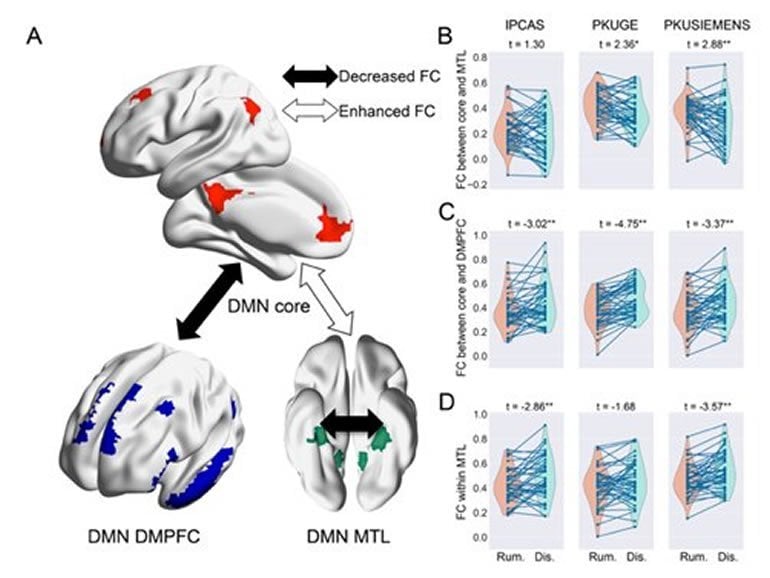Summary: Researchers have uncovered the neural mechanism underlying rumination. The study reports when rumination occurs, coupling between the core and medial temporal lobe subsystems of the default mode network becomes elevated while coupling between the core and dorsomedial prefrontal cortex decreases.
Source: Chinese Academy of Science
Rumination is generally defined as a recurrent and passive focus of thoughts on depressed mood itself and its possible causes and consequences. Sometimes stated as “overthinking,” rumination plays a pivotal role in the onset, maintenance and phenomenology of major depressive disorder (MDD). However, the neural mechanism behind this thinking style remains largely elusive.
Recently, a research team led by Prof. Yan Chaogan from the R-fMRI Lab at the Institute of Psychology of the Chinese Academy of Sciences have uncovered the underlying network mechanisms during active rumination.
With a modified rumination state paradigm, the researchers induced participants to engage in rumination while undergoing functional magnetic resonance imaging (fMRI) scans.
Then they computed the Pearson’s correlation during the activity among different brain regions. Results revealed that couplings between the core and the medial temporal lobe (MTL) subsystems of the default mode network (DMN) were elevated while the other couplings were decreased.
This dissociation may reflect the over-restriction of self-referential and affective appraisal regions on the regions engaging in autobiographical recollection and generation of spontaneous thoughts, while other unrelated regions become uncoupled to allow for more information exchange among those involved regions.

The finding raised the possibility that a treatment targeting rumination may have better efficacy if it can reduce the over-connectivity and enhance reduced connectivity. One potential way to help individuals to disengage from rumination may be through mindfulness practice, a receptive and non-evaluative attention to the immediate experience.
The research, titled “The subsystem mechanism of default mode network underlying rumination: A reproducible neuroimaging study,” has been published in NeuroImage.
About this neuroscience research article
Source:
Chinese Academy of Science
Contacts:
Zhang Nannan – Chinese Academy of Science
Image Source:
The image is credited to CHEN Xiao.
Original Research: Open access
“The subsystem mechanism of default mode network underlying rumination: A reproducible neuroimaging study” by Xiao Chen et al. NeuroImage.
Abstract
The subsystem mechanism of default mode network underlying rumination: A reproducible neuroimaging study
Rumination is a repetitive self-referential thinking style that is often interpreted as an expression of abnormalities of the default mode network (DMN) observed during “resting-state” in major depressive disorder (MDD). Recent evidence has demonstrated that the DMN is not unitary but can be further divided into 3 functionally heterogenous subsystems, although the subsystem mechanistically underlying rumination remains unclear. Due to the unconstrained and indirect correlational nature of previous resting-state fMRI studies on rumination’s network underpinnings, a paradigm allowing direct investigation of network interactions during active rumination is needed. Here, with a modified continuous state-like paradigm, we induced healthy participants to ruminate or imagine objective scenarios (distraction, as a control condition) on 3 different MRI scanners. We compared functional connectivities (FC) of the DMN and its 3 subsystems between rumination and distraction states. Results yielded a highly reproducible and dissociated pattern. During rumination, within-DMN FC was generally decreased as compared to the distraction state. At the subsystem level, we found increased FC between the core and medial temporal lobe (MTL) subsystem as well as decreased FC between the core and dorsal medial prefrontal cortex (DMPFC) subsystem and within the MTL subsystem. Finally, subjects’ behavioral measures of rumination and brooding were negatively correlated with FC between the core and DMPFC subsystems. These results suggest active rumination involves enhanced constraint by the core subsystem on the MTL subsystem and decreased coupling between the core and DMPFC subsystem, allowing for more information exchange among those involved DMN components. Furthermore, the reproducibility of our findings provides a rigorous evaluation of their validity and significance.







